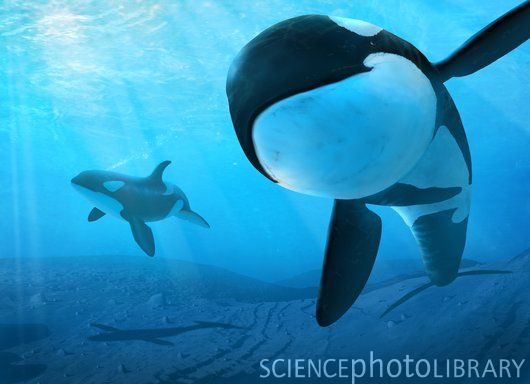 就像冬天来了人们总想跑到热带的温泉(SPA)以摆脱寒冷一样,栖息在南极海岸附近的杀手鲸(又称逆戟鲸)有时候也会离开冰冷的家乡海域而小憩片刻。
就像冬天来了人们总想跑到热带的温泉(SPA)以摆脱寒冷一样,栖息在南极海岸附近的杀手鲸(又称逆戟鲸)有时候也会离开冰冷的家乡海域而小憩片刻。
对这种生活在地球最南端的6米长的鲸目动物进行的首个人造卫星标记显示,全部5头进行了标注的杀手鲸都会在3周多的时间里,离开通常属于它们的2摄氏度的海 域,向东前往位于乌拉圭和巴西海域的20摄氏度的福克兰群岛。其中一头杀手鲸在42天的时间里游完了长达9400公里的往返行程。
这些杀手鲸在前往北方目的地的过程中会以更慢的速度游水,然而它们在狩猎或照顾幼鲸的时候却从未真正降低过游水的速度,这意味着这些远行并非像典型的鲸类迁徙那样是为了觅食或繁殖。
事实上,研究人员日前在《生物学快报》网络版上指出,杀手鲸前往更温暖的海域是为了恢复它们的皮肤——这些事情是鲸类在寒冷的水中所无法完成的,因为这一过程会将热血从它们的身体内部消耗掉。
海豹通过爬上陆地脱皮来解决这一问题,然而由于缺乏这样的本领,杀手鲸或许真的需要展开一次SPA之旅。
逆戟鲸是一种大型食肉动物,体重9吨左右,背呈黑色,腹为灰白色,牙齿锋利,性情凶猛,善于进攻猎物,是企鹅、海豹等动物的天敌。有时它们还会袭击其他鲸类,甚至是大白鲨,可称得上是海上霸王。
相关英文论文摘要:
Antarctic killer whales make rapid, round-trip movements to subtropical waters: evidence for physiological maintenance migrations?
Killer whales (Orcinus orca) are important predators in high latitudes, where their ecological impact is mediated through their movements. We used satellitetelemetry to provide the first evidence of migration for killer whales, characterized by fast (more than 12 km h?1, 6.5 knots) and direct movements away from Antarctic waters by six of 12 type B killer whales tagged when foraging near theAntarctic Peninsula, including all tags transmitting for more than three weeks. Tags on five of these whales revealed consistentmovements to subtropical waters (30–37° S) off Uruguay and Brazil, in surface water temperatures ranging from ?1.9°C to 24.2°C;one 109 day track documented a non-stop round trip of almost 9400 km (5075 nmi) in just 42 days. Although whales travelledslower in the warmest waters, there was no obvious interruption in swim speed or direction to indicate calving or prolongedfeeding. Furthermore, these movements were aseasonal, initiating over 80 days between February and April; one whale returnedto within 40 km of the tagging site at the onset of the austral winter in June. We suggest that these movements may representperiodic maintenance migrations, with warmer waters allowing skin regeneration without the high cost of heat loss: a physiologicalconstraint that may also affect other whales.







